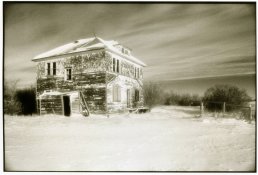I'm also a fan of the Rollei (both 80s and 400s), since they both go into the infrared range and can be shot normally as well. I did some tests a few years ago (with SFX), but I don't have access to those files at the moment. I don't mind SFX either - but I use more as a regular film (with a red filter) - it has an infrared feel without a strong infrared look, and I like that subtlety.
Just a note on using infrared - you can use it year-round, it doesn't have to only be from spring to fall (all you need is an infrared source - the sun, fire, tungsten - they all work). In fact, I love using it in the winter. The skies are free of haze and you can get some really nice results. Old wood is fantastic in infrared - shoot anything - an old barn, a forest, etc. in both regular black and white and infrared and you'll see a big difference. Really, what I like infrared for is in the gradation of the highlights - it has it's own specific look, nothing else looks like it. Here's an example (I've got more in my gallery) - this is an old farmhouse that I've photographed several times and I can tell you that the wood looks completely different in regular black and white. This was also an overcast day, but with infrared, it goes right through the clouds, which gave them that wispy effect (this was shot on HIE).











